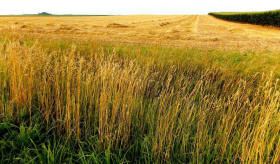|
 June June
The weather during month of June already made farmers nervous
because it was a much wetter month than usual. According to weather
statistics, the average rainfall in the area (using the city of
Lincoln for the purposes of gathering data) in the month of June is
just under four-and-a-half inches. June of 2014 was a particularly
wet June with a precipitation total of a little under six-and-a-half
inches, with 7th of June bringing the biggest one-time rain at
one-and-a-half inches.
It is easy to imagine that farmers in Logan County remembering the
prior year would brace themselves for the possibility that it could
happen again. Prior to June 21st of 2015, the first day of summer,
rainfall levels were still lower than average, and it seemed like
the current year would be chalked up to random chance.

On June 25th
the Emergency Management Agency opened its Emergency
Operations Center and called a new conference.
Responders had already made more than a dozen water rescues,
many field to field flood related, and with more rain in the
forecast were put on high alert as area creeks and waterways
were reaching record flood stages. |
Then, the last ten days of June brought five-and-a-half inches of
rain with them. The total amount of rainfall in June measured at
over nine-and-three-quarters inches of precipitation. The wettest
day was the 28th, when two inches of rain fell. Areas north of
Lincoln, particularly along Route 136 from east to west experienced
a couple record breaking single event rains that came relatively
close together.
 Many farmers in Illinois and in surrounding states were already
behind in planting crops due to the wet spring. Flooding rivers in
June and early July caused even further delays and killed some of
the crops that had been planted. The month of July would pose a
serious problem if it brought more rain.



Just north of
Lincoln in early July, this uncommon to Logan County wheat
field was harvested. It is located on high ground and
was flanked this year by corn to the south and soybeans to
its north. Across the road, soybeans tested recently
tiled lower ground. |
[to top of second column] |

July
In this area, rainfall totals in July average out to just over five
inches of rain. In July of 2014, the rainfall total measured a
little over four-and-three-quarters inches; just under the average
rainfall. The wettest day for last year was the 8th of July, with
one-and-a-quarter inches of rain.
In July of this year, the last thing fields needed was more rain.
Farmers were still recovering from the rains of June, and crops are
not normally planted in July, even to replace what was lost from
flooding. But the rainfall continued in July, bringing a total of
nearly six inches of rain. Interestingly enough, as in 2014, the 8th
of July 2015 was once again the wettest day, with almost
two-and-a-half inches of rainfall. The last day of significant
rainfall in July was the 19th, when three-tenths of an inch fell.
The next weather related kick at Logan County's Agriculture starting
on the weekend of July 18. Here forward there would be long streaks
of not only dry, but high temperatures with no cool-off at night
which would lead to - 'Summer kill.' From this point forward
affected corn stopped producing sugar in the kernels.
August
Looking ahead to August, it was expected that rain would continue,
as August of 2014 came with over six inches of rain. Now in 2015, as
July transitioned into August, the rain let up, and farmers were
able to breathe a sigh of relief.
The dry weather in August of 2015 was welcome at first. The highest
amount of rain was on the 9th, but it was only six-tenths of an
inch. On average, August rainfall measures at a little under four
inches of rain, which makes it easy to see why 2014 was causing
alarm.
As the month moved on, Logan County continued moving into a very dry
period. In total, barely over an inch of rain fell in the area
during the month of August.
Farmers were grateful for the dry August that followed a very wet
June and July. The dryer-than-usual weather made for it easier for
harvests to begin on schedule. Farmers across central Illinois
reported that the dry conditions made harvesting quick and easy this
year. According to a report from the Illinois Department of
Agriculture, as of October 7th, over fifty percent of the state’s
corn and soybean crops were harvested.
As the harvest season is coming to an end soon, farmers are no doubt
looking at next year and trying to prepare. It is too early to say
whether or not next year will bring more rain. For farmers, it is
likely too difficult to imagine a wetter growing season than 2015,
even with it ending on a dry note.
Resources Cited
|